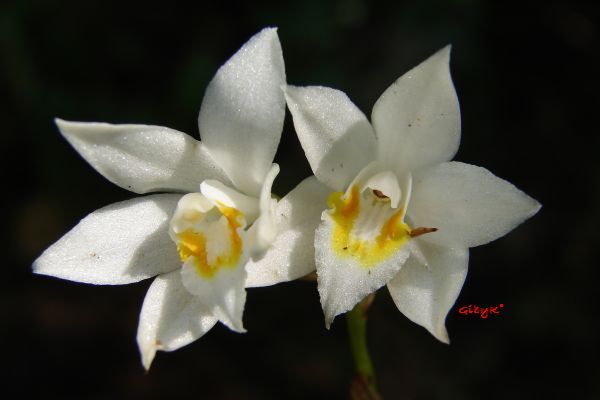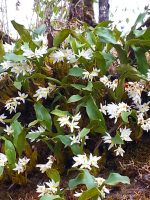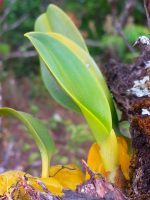|
Coelogyne nervosa A.Rich., Ann. Sci. Nat., Bot. II, 15: 16 1841. (Syn: Coelogyne corrugata Wight; Pleione corrugata (Wight) Kuntze; Pleione nervosa (A.Rich.) Kuntze); Orchidaceae Fortnight: Coelogyne nervosa_151013-GK-13 : Attachments (1). 4 posts by 4 authors. Its more than excellent shot….
ANMAR51/73 Coelogyne sp. for ID : 8 posts by 4 authors. Attachments (13)
Family: Orchidaceae god… you have a talent for finding stuff
wonderful photos efi page on Coelogyne nitida Was this wild? If this is wild then this is Coelogyne nervosa. C. nitida is not reported from southern part of India as far as I know. This is Coelogyne nervosa A. Rich. Very much wild, … It was growing on trees and rocks in an evergreen forest. Thank you very much … Orchid for id from Mullaiyanagiri,Chikmagalur : 6 posts by 2 authors. Attachments (3) Forwarding few images of an Orchid for Id assistance.
Date/Time: 2-03-2015 about 2-00 PM
Location- Place, Altitude: Mullaiyanagiri, Chikmagalur, Karnataka, about 1700 msl. Habitat- Garden/ Urban/ Wild/ Type: Wild Plant Habit- Tree/ Shrub/ Climber/ Herb: Epiphytic and lithophytic orchid. This one is Coelogyne nervosa recently identified for me on this post.
Same place sir, near the temple at the top of Mullayanagiri Coelogyne sp…..either mossiae or nervosa. To me this looks like Coelogyne nervosa. Coelogyne nervosa 17-6-2015_Mullaiyanagiri_2 for ID assistance. : 4 posts by 3 authors. Attachments (3) Submitting images of a specimen of an epiphytic orchid for identification……Coelogyne sp…???
Date/time:17-07-2015 about 10-30 am
Location: Mullaiyanagiri, Chikmagalur, Karnataka about 1700 msl
Habitat: Wild, Shola forest
Habit; Epiphytic orchid some species of Bulbophyllum i think This is Coelogyne nervosa A. Rich, Endemic to western ghats. TSPOCT2015-8:Images of Coelogyne nervosa shared : 7 posts by 3 authors. Attachments (2) It is my pleasure to share a few images of Coelogyne nervosa (Orchidaceae)
Habit: Epiphytic
Habitat: Moist deciduous and semi-evergreen forests
Sighting: Mullaianagiri, Chikmagalur, Karnataka, 1700 msl.
Date:17-07-2015 can you tell me what are those yellowish “container” like structures in the left side of the first picture? Those are old pseudobulbs from which leaves have fallen off. In most of the orchids and in Coelogyne a new shoot comes up from teh side of the previous years pseudobulb and gradually either flowers first (if the inflorescence is coming from the apex of the pseudobulb) or gives out proper leaves first (usually when inflorescence emerged out from the base of the pseudobulb). They are kind of storehouse of food for the plants. One plant (one pseudobuld) will give flowers only once in its life time, after that usually they are of no use except helping in the next generation that emerges out from the base of it to grow. But these pseudobuls with rhizome can be cut off and it can give new shoot if replanted properly.
Now why it is called PSEUDOBULB and NOT BULB.
Its called pseudobulb because it is not a true bulb. A true bulb is a modification of a leaf. This is kind of modified organ formed below leaf, but it is not part of leaf (not petiole) so its called pseudobulb. No one knows whether to call it a leaf or stem or root (definetly not a root). so now i want to know if you took more pictures of this pesudobulb and its rhizome by any chance? . 487-TSP-17MAR2021-1-
Presenting an image of Coelogyne nervosa,Orchidaceae Habit:Herb Habitat:Wild,Epiphytic,Shola forest Sighting:Mullaianagiri,Chikmagalur,Karnataka about 1700 msl Date:24-03-2016 . 488-TSP-17MAR2021-2- Yes looks like Coelogyne nervosa
. References: |
Disclaimer
1. For any mistake in identification or for becoming efloraofindia e-group member (for contributing towards building of efloraofindia or otherwise), pl. mail to indiantreepix@googlegroups.com or itpmods@googlegroups.com
2. For better viewing of species’ pages, colour scheme & formatting is being followed as: Description of the species, Details of other flora species on the same page, Uses/ harms, Distribution, Abundance/ Location/ Flowering time & date, Habit & habitat, Etymology & pronunciation, Other interesting information, stories etc., Others, Botanical names, Common names, Main point of discussion below, Discussion about Botanical names.
Navigation
- Award for eFloraofIndia
- Colour scheme & formatting
- Copyrights, Permissions, Citations
- eFloraofIndia appreciated
- Names of Plants in India site
- Flowersofindia site
- Posting Guidelines
- For members’ information
- Logo, Tagline, Acronym
- Volunteers required
- ‘Pitamah’ of eFloraofIndia
- ‘अजेय’ ‘Ajey’ of eFloraofIndia
- ‘Saarthi’ ‘सारथि’ of eFloraofIndia
- ‘Jewel’ of eFloraofIndia
- ‘Grassman’ of eFloraofIndia




